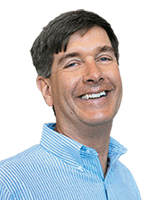Suppressing annual bluegrass seedheads
Bruce Branham, Ph.D., is a turfgrass scientist at the University of Illinois. He has conducted research on annual bluegrass management and control for more than 30 years. Bruce can be reached at bbranham@illinois.edu for more information.

Cark Throssell
Q: What is a reasonable expectation of annual bluegrass seedhead suppression on a putting green using a plant growth regulator?
First, keep in mind that the intensity of annual bluegrass (Poa annua) seedhead production varies greatly from one year to next. In some years seedhead production is modest and in other years there is a bumper crop of seedheads. This means that if a plant growth regulator (PGR) provides 80 percent control, in a year of modest seedhead production there will be only a few seedheads present. That same 80 percent control during a year with a bumper crop of seedheads means there will be a noticeable amount of seedheads present. Leave an untreated area 5 feet by 5 feet in an out-of-the-way part of several greens so you can judge the effectiveness of the PGR application.
A Primo (trinexapac-ethyl) + Proxy (ethephon) application will generally provide 70 percent to 80 percent seedhead suppression, with a variation of suppression from year-to-year of 50 percent to 90 percent suppression.
A low rate weekly application of Embark (mefluidide) can provide close to 100 percent seedhead suppression.
Q: What products are available to suppress annual bluegrass seedheads?
Primo + Proxy is widely used because it has a good safety margin to the desired turf and will generally provide 70 percent to 80 percent seedhead suppression. Primo + Proxy is a good combination because each product has strengths the other does not have.
Embark is gaining in popularity for seedhead suppression because it provides nearly 100 percent suppression when applied weekly at a low rate. Applying Embark weekly at a low rate minimizes the risk of discoloring the turf while still supressing seedheads. Superintendents have been persistent in figuring out how to use Embark to suppress seedheads while keeping turf damage potential low. Additional research on the use of Embark on greens would be a help to the industry.
Do not tank mix a product that contains non-chelated iron with Embark. Non-chelated iron antagonizes Embark and will reduce the effectiveness of an Embark application.
Trimmit (paclobutrazol) and Cutless (flurprimidol) can be applied to greens to reduce the population of annual bluegrass but they do not provide seedhead suppression. Trimmit will reduce the height of the seedheads, making them more difficult to see, and will reduce some of the bumpiness they cause, but will not suppress the number of seedheads present.
Q: What is the recommended timing of PGR applications to suppress annual bluegrass seedheads?
For both Primo + Proxy and Embark, the turf should be completely green, the putting green should have been mowed once or twice, and no annual bluegrass seedheads should be present.
There is a good model that Ron Calhoun, Ph.D., and others developed that can be found at gddtracker.net to help time applications of Primo + Proxy, Embark and other pesticides.
Q: If seedheads are present in the latter part of spring, what can be done?
Once seedhead production starts, it is difficult to make a difference at that point.
Q: Anything else you would like to add?
Make a concerted year-round effort to reduce annual bluegrass populations so a superintendent will not have to worry as much about seedhead suppression. In situations where the green is dominated by annual bluegrass, consider regrassing with a new cultivar of creeping bentgrass. The new cultivars of creeping bentgrass are much more competitive with annual bluegrass than the older cultivars, reducing the invasiveness of annual bluegrass. It is easier to control annual bluegrass when there is only 5 percent versus 25 percent or 50 percent.








